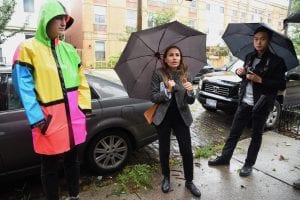As we move into the second full week of classes and internships, I am glad to finally feel oriented enough to begin to embrace the chaos of New York City. I know which sink in the bathroom never works, not to take the J train on a Saturday if I’m in a hurry, and that I am never going back to the disappointing ramen place on 28th Street again. I know that the number of times I can get away with claiming I’m late because the train was delayed are dwindling, and my poor time management will soon be exposed for good. I know my studiomates well enough to no longer avoid eye contact in the hallway, making friendly chitchat out of growing connections not just obligation of proximity. And as I think about what is to come and what it will feel like, I am excited to realize that I don’t really know, something I haven’t been able to claim in a while.

Last Monday, both the urban design and architecture studios visited Red Hook, Brooklyn. This semester all students at AAP NYC will be focusing our studio projects on this neighborhood for the entire semester. Today, desks are littered with sketches of street sections, photos of building density, and annotated diagrams of block typology. Maps, collages of architectural detail, and demographic charts are pinned on the wall. It’s hard to believe that less than two weeks ago we visited this place for the first time.

The weather was gloomy, but it seemed very appropriate for a visit to a community so connected to the water. Although the ferry was highly modern (even boasting a members-only Margarita Mondays out of the full-service snack and drinks bar) being in such close proximity to the Hudson on such a foggy day felt rustically nautical.

The planners and landscape architects were guided by Eugenia Di Girolamo, one of the instructors of the Urban Design Studio and an urban designer at the NYC Department of City Planning. Learning about a place while walking through it was fascinating, our first foray into the “city as classroom.” We learned about gentrification pressures while commenting on the building materials of luxury housing development and the creative programming of repurposed warehouse spaces. We discussed the neighborhood’s spatial isolation while attempting to traverse the horrific pedestrian experience underneath the Gowanus Expressway and passing by infrequent bus stops for the singular line servicing the neighborhood. We witnessed immense variability, from brick townhomes to active warehouses to one of the largest NYCHA public housing complexes in the city. It was incredible to witness so much packed into a community only one mile across, and so exciting to think about all the other neighborhoods yet to explore on my own time.

It is an undeniable cliché that time passes differently in New York City. Being at Cornell in Ithaca can feel like treading water or swimming against a current. You try to focus on your individual movements in the hope you’ll make slight progress toward an endpoint that is probably still there but is most of the time out of sight. New York City feels more like being pulled by a mild undertow. I was prepared for the time to fly by, but not this sense of constant forward motion. Perhaps it’s the monumental development projects all around us, the spatial chronicle of hundreds of years of history, or maybe it’s just the momentum of the millions of lives constantly moving beside, above, and below us. This semester is clearly going to be one of exploration and discovery. Onward!
